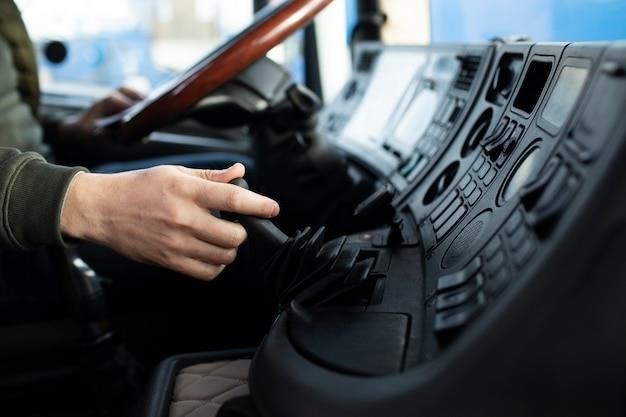
4l60e manual shift
4L60E Manual Shift⁚ A Comprehensive Guide
This guide provides a comprehensive overview of 4L60E manual shifting, exploring the intricacies of this popular transmission modification. We’ll delve into the fundamentals of manual shifting, examine its advantages and disadvantages, and provide insights into various methods for achieving manual shift control. The guide will also cover popular 4L60E shift kits, troubleshooting tips, and essential maintenance practices. Whether you’re a seasoned mechanic or a curious enthusiast, this guide will equip you with the knowledge needed to understand and implement manual shifting in your 4L60E transmission.
Introduction
The 4L60E, a ubiquitous automatic transmission found in countless General Motors vehicles, has earned a reputation for durability and adaptability. While its automatic operation is convenient, enthusiasts and performance-minded drivers often seek greater control over their vehicle’s shifting behavior. Enter the world of manual shifting, a modification that empowers drivers to take command of their 4L60E transmission, unlocking a world of customized shifting experiences. This guide embarks on a journey into the realm of 4L60E manual shifting, illuminating the intricacies of this popular modification.
Manual shifting a 4L60E goes beyond mere gear selection. It allows drivers to dictate shift points, maximize engine braking, and achieve lightning-fast shifts, all while fine-tuning the transmission’s behavior to suit their specific driving style and vehicle application. Whether you’re pursuing enhanced performance, improved fuel economy, or simply the thrill of manual control, understanding the nuances of 4L60E manual shifting is crucial. This guide will serve as your roadmap, exploring the fundamentals, benefits, drawbacks, and practical methods of achieving manual shift control for your 4L60E transmission.
Understanding the 4L60E Transmission
The 4L60E, a cornerstone of General Motors’ automatic transmission lineup, has become a staple in the automotive world. This robust transmission, designed for longitudinal engine configurations, boasts four forward gears and a single reverse gear, making it a versatile option for a wide range of vehicles. The 4L60E’s popularity stems from its durability, adaptability, and ease of maintenance, which have cemented its status as a reliable workhorse in both stock and modified applications.
At its core, the 4L60E is an electronically controlled automatic transmission. This means its shifting behavior is determined by a complex interplay of sensors, solenoids, and the vehicle’s computer system. The computer constantly monitors various parameters, such as engine speed, throttle position, and vehicle speed, to determine the optimal shift points. While this automatic operation provides convenience and efficiency, it also limits the driver’s ability to tailor the transmission’s behavior.
This is where the concept of manual shifting comes into play. Manual shifting a 4L60E involves modifying the transmission’s internal components or electronics to bypass the computer’s control and allow the driver to manually select gears. This opens up a world of possibilities for those seeking greater control over their vehicle’s performance and handling.
The Basics of Manual Shifting
Manual shifting a 4L60E involves taking control of the transmission’s gear selection process, allowing the driver to choose when to shift gears rather than relying on the automatic computer. This provides a greater sense of control and responsiveness, particularly in performance-oriented driving situations. However, it’s important to understand the fundamentals of manual shifting to ensure safe and efficient operation.
At its core, manual shifting involves bypassing the automatic control system and directly engaging the desired gear through mechanical or electronic means. This can be achieved through various methods, including installing a manual valve body, using a standalone controller, or even modifying the existing computer programming. Each method has its unique advantages and drawbacks, impacting factors such as cost, complexity, and level of control.
The process typically involves using a shifter, either a traditional lever or a custom setup with buttons or paddles, to select the desired gear. Once selected, the transmission’s internal mechanisms engage the gear, allowing the engine to deliver power to the wheels. Manual shifting requires a greater understanding of the transmission’s behavior and how different gear ratios affect performance and fuel economy.
Benefits of Manual Shifting
Manual shifting a 4L60E offers several advantages that can enhance the driving experience and performance of your vehicle. These benefits stem from the driver’s ability to take control of the gear selection process, optimizing the transmission’s behavior for specific driving conditions.
One of the most notable benefits is improved acceleration. By manually shifting, drivers can hold a gear longer, allowing the engine to rev higher and deliver more power. This is particularly beneficial for launching off the line or accelerating quickly through corners. Furthermore, manual shifting grants more precise control over engine braking, allowing for smoother and more controlled downshifts.
Manual shifting also offers a greater sense of engagement and driver involvement. The ability to manually select gears allows drivers to feel more connected to the vehicle’s performance and respond more directly to changing road conditions. This can be particularly rewarding for enthusiasts who enjoy a more hands-on driving experience.
Finally, manual shifting can be beneficial for towing and hauling. By selecting the appropriate gear for the load, drivers can optimize engine torque and transmission efficiency, reducing strain on the transmission and improving fuel economy.
Disadvantages of Manual Shifting
While manual shifting a 4L60E can offer various benefits, it also comes with certain drawbacks that should be carefully considered before embarking on this modification. One significant disadvantage is the increased complexity and potential for driver error. Manual shifting requires a greater understanding of the transmission’s operation and the ability to select the appropriate gear for different driving situations. Incorrect gear selection can lead to transmission damage or performance issues.
Another drawback is the potential for increased wear and tear on the transmission. Manual shifting, particularly under heavy loads or high RPMs, can subject the transmission to greater stress, potentially leading to premature component failure. Additionally, manual shifting can make it challenging to maintain smooth and seamless gear changes, particularly when transitioning between gears at high speed or under heavy acceleration.
Furthermore, manual shifting can negatively impact fuel economy. While manual shifting can be beneficial for towing or hauling, it can also lead to increased fuel consumption in everyday driving situations. The constant need to manually shift gears can result in more aggressive driving habits, which can consume more fuel. Finally, manual shifting can be more demanding on the driver, requiring greater concentration and effort to maintain smooth and efficient gear changes.
Methods for Achieving Manual Shift
Converting a 4L60E to manual shift involves several methods, each offering varying levels of control and complexity. One common approach is to utilize a TransGo Reprogramming Kit, which provides full manual control for upshifting and downshifting through all four gears. These kits effectively eliminate automatic shift functions, allowing the driver to manage gear changes entirely. Another option is to install a standalone transmission controller, such as the labwork 4L60E Stand Alone Controller Manual Shifter Microcontroller.
This type of controller replaces the factory computer, enabling independent control of shift solenoids and the torque converter clutch. Additionally, manual shifting can be achieved by modifying the transmission’s valve body. This involves replacing or modifying internal components to create a full manual valve body, allowing the driver to shift gears using the transmission’s lever. While this method offers a more direct and mechanical approach, it requires a greater understanding of the transmission’s internal workings and may necessitate specialized tools and expertise.
Finally, some enthusiasts choose to create a custom manual shifter using switches or other electronic components. This method allows for a more personalized approach but requires a thorough understanding of electrical systems and wiring diagrams. Regardless of the chosen method, converting a 4L60E to manual shift requires careful planning, meticulous execution, and a thorough understanding of the transmission’s operation.
Popular 4L60E Shift Kits
For those seeking to enhance their 4L60E’s performance and shifting characteristics, various shift kits are available on the market. Two of the most popular options include the TransGo Performance HD2 and the Sonnax Performance Pack. The TransGo HD2 kit is designed to improve shift firmness and responsiveness, providing a more aggressive feel for both street and track applications. This kit tackles common issues like TCC slip, harsh 1-2 shifts, and inconsistent pressure boost problems.

It also enhances overall transmission durability. The Sonnax Performance Pack, on the other hand, offers a more comprehensive solution, addressing multiple aspects of the transmission’s performance. It incorporates components like a line pressure booster kit, spacer and spring for the pump, and a pinless forward accumulator piston to increase line pressure and improve shift quality. Both kits are relatively easy to install, requiring basic hand tools and a few hours of work. They can dramatically alter the 4L60E’s shifting characteristics, providing a more aggressive and responsive driving experience.
However, it’s important to note that while these kits can improve performance, they may also increase wear and tear on the transmission, especially when used in demanding applications. Choosing the right kit depends on your specific needs and driving style. It’s advisable to consult with a reputable transmission specialist to determine the best kit for your particular application and ensure proper installation.
Troubleshooting and Maintenance
While the 4L60E is a robust transmission, like any mechanical system, it requires regular maintenance and troubleshooting to ensure optimal performance. One common issue with manual-shifted 4L60E transmissions is the tendency for harsh shifts, especially when downshifting. This can be caused by various factors, including worn clutch packs, faulty solenoids, or incorrect shift kit adjustments. If you encounter harsh shifting, it’s crucial to diagnose the root cause. Inspect the clutch packs for wear, check the solenoids for proper operation, and ensure the shift kit is properly installed and adjusted.
Another common issue is TCC slip, which can occur due to worn clutch packs, a faulty torque converter, or a problem with the TCC solenoid. To troubleshoot TCC slip, inspect the clutch packs and torque converter for wear, and check the TCC solenoid for proper operation. Regular fluid changes are essential for maintaining the 4L60E’s health. Using the recommended ATF fluid and following the manufacturer’s fluid change intervals can significantly extend the transmission’s lifespan. Furthermore, monitoring the transmission’s temperature is vital, as overheating can lead to premature wear and failure. Install a transmission temperature gauge and avoid excessive towing or prolonged high-load operation to prevent overheating.
Finally, it’s always a good idea to have your 4L60E inspected by a qualified transmission specialist at regular intervals. They can perform a thorough inspection, identify potential issues early, and recommend any necessary repairs or maintenance. By following these tips, you can help ensure your 4L60E transmission operates smoothly and reliably for years to come.
Converting a 4L60E transmission to manual shift offers a unique driving experience, granting drivers precise control over gear changes and enhancing performance potential. Whether you’re seeking improved acceleration, enhanced control during spirited driving, or simply a more engaging driving experience, the 4L60E manual shift modification can deliver. However, it’s essential to understand the complexities involved and approach the conversion with meticulous care. Thorough research, proper installation, and regular maintenance are crucial for ensuring the transmission operates reliably and performs as intended.
While manual shifting provides a more direct and engaging driving experience, it’s not without its drawbacks. It requires greater driver input and coordination, potentially leading to increased wear on clutch packs if not executed properly. Moreover, the 4L60E’s electronic controls are bypassed, eliminating the benefits of computer-managed shift points and torque management. However, with careful planning, proper execution, and a commitment to regular maintenance, the 4L60E manual shift conversion can be a rewarding modification, enhancing the performance and driving experience of your vehicle.